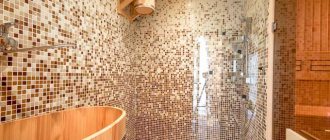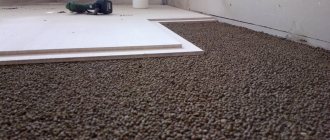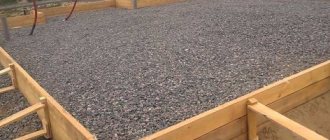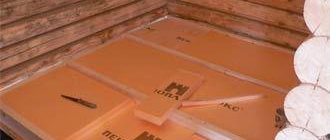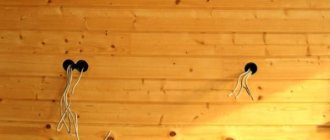If you are faced with the task of decorating a wooden wall with tiles, then in this article we will tell you how to do it and avoid making serious mistakes. The fact is that wood, as a material, is not the most stable finishing option, for the sole reason that wood breathes, which means the cement base of the adhesive used for laying tiles can crack. As a result, your tiled wall will soon begin to crack at the seams and ultimately either lose its appearance or simply fall apart.
Let's start installing tiles on a wooden wall
- First of all, you need to use any antiseptic in order to protect your wooden walls from rotting. Since wooden walls can absorb moisture, this is a very important point; do not neglect the use of antiseptic!
- Afterwards you need to glue the roofing felt to the wooden wall. It will protect the tree from destruction. During the drying process, the cement mortar releases moisture, therefore, if you do not protect the wall with roofing felt, it will absorb all the moisture, thereby causing the formation of fungus or mold.
- Next, at a short distance from the wall, you need to mount a metal mesh, which will serve as a reinforcing material and will prevent your wall from crumbling. To install the mesh at a distance from the wall, it is advisable to use slats. This way you will give the wood the opportunity to breathe without destroying your structure.
- Afterwards, you need to roll the entire wall into cement mortar. Be sure to use cement mortar and not gypsum, otherwise you may have problems with the wall in the future. After applying the solution, it must be allowed to completely harden. Moreover, it is advisable to periodically wet the wall with water for three days so that the cement becomes as strong as possible.
- Next, we move on to the work of cladding a non-wooden wall.
- Before starting work, it is advisable to soak the tiles in water for 5 hours. Tiles soaked in moisture will have better adhesion, which will significantly increase their chances of durability.
- Be careful, because sometimes due to a violation of the tile production technology, stains may appear on it when soaked. We recommend testing one or two tiles before soaking the entire material. Those tiles on which stains appear must be returned and replaced. If you don’t want to take risks, use a spray bottle with water and simply wet the inside of the tile.
- The main thing when facing is to do everything smoothly. In simple terms, the first tiles set the vertical and horizontal of the entire future cladding. Therefore, use a bubble level or laser level to correctly lay out the first tiles.
- When laying tiles on the wall, use crosses to ensure that the width of the joints between all tiles is the same. At least two crosses are installed on each tile. It is advisable to install along the edges of the tiles to avoid accidentally bevelling.
- The solution must be laid on the inside of the tile, leveling it with a comb or trowel, and then apply the tile to the wall.
- If excess mortar appears along the contour of the tile, simply remove it using a scourer.
- After the solution has completely hardened, it is necessary to remove all the crosses, clean the horizontal and vertical seams, and then fill the solution with plaster, or better yet, with a special grout for tiles.
Summary
It is possible to lay tiles in the bathroom on the walls and floor in a wooden house, the main thing is to find the optimal approach.
Gluing ceramics directly to walls and floors is possible only with special adhesive solutions based on epoxy resins or polyurethane; the use of cement-sand glue with additives can cause damage to the base - saturating it with water and insulating it from air.
Experts still recommend using an integrated approach to cladding and installing an additional base of plywood or drywall - this is exactly what real professionals do. This method has a number of advantages:
- the main wood does not suffer in any way, therefore it retains its properties and integrity longer;
- the cladding can be dismantled at any time, again without harm to the main wall or floor;
- The wood has constant contact with air, which means it does not accumulate moisture and does not dry out, and the natural balance of moisture inside the timber is maintained.
Whatever installation method is chosen, special attention should be paid to adhesive compositions: read the instructions and description. Perhaps the mixtures have narrowly targeted properties that are suitable specifically for your room (humidity, type of materials used, etc.).
- Exterior finishing
Is it a good idea to tile wooden walls?
Frankly speaking, if we consider the option of finishing wooden walls with tiles, or finishing walls with another material, the following conclusions arise.
If you have never laid tiles on wooden walls, then it is better not to risk it and hire a professional who specializes in such work. In this case, you will at least be sure that your wall will not crack after a while, and most importantly, you will be sure that the process of wood rotting and the formation of mold and mildew has not begun under the tiles.
If you decide to do the work yourself, we strongly recommend that you choose another material for cladding that does not require such careful preparation of the walls. Otherwise, simply try to comply with all the necessary technical points in order to reduce possible problems to a minimum.
Preparation for installation
Various options for finishing
Often you have to make repairs in an old house, so in this case it is better to remove the old tiles and, after dismantling, adjust the corners of the walls and check them for the degree of curvature.
The building level will help with this. And since the curvature indicators will be disappointing, you need to eliminate the problem with the help of beacons to the level of the plaster.
This is a rather labor-intensive process, but the quality of the entire masonry may depend on its result.
The curvature has been dealt with, now you can prime the wall, thanks to which in the future, when applying the adhesive composition, you will get good adhesion. On plasterboard walls, you can lay tiles on a primer.
The same material (plasterboard) is good for leveling old surfaces instead of using plaster. Next, it is important to competently approach the choice of adhesive composition for tiles.
What are the reasons
- Even if there are minimal conditions for the formation of humidity or generally changes in temperature conditions, the wood will expand and contract depending on the air.
- The tiles and the mortar itself also have the ability to change depending on air humidity and room temperature.
- The tile itself is very fragile, it is comparable only to glass, so for its installation you need the most static base.
- Wood, even covered with tiles, will still absorb moisture from the environment, so without any care it will begin to rot and form fungus and mold.
- The seams, which are made of gypsum grout, will begin to crack soon after installing the tiles on a wooden wall, and then your tiles will begin to crack.
Which tile adhesive to choose
To install ceramics on a wooden or plywood base, you should choose an elastic adhesive based on:
- polyurethane;
- epoxy resins.
These materials serve as both fasteners and waterproofing. Glue with natural and artificial resins is sold in finished form, and two-component adhesives are sold in powder form, which must be diluted with water before use according to the instructions.
You can also use “liquid nails”, which are suitable for working in wet conditions. These retain their load-bearing properties even when exposed to moisture; the usual composition for bathrooms and kitchens is a short-lived option.
Preparation of tools and materials
To ensure ease of work you will need:
- tools for inspecting and repairing a wooden floor - an awl or a thick needle for assessing the density of wood, chisels and knives for filling cracks and removing shallow spots of mold and rot, a plane for trimming, a hacksaw (grinder, jigsaw), a grinder or sandpaper on a block for cleaning surface layer, hammer, nails or self-tapping screws (screws);
- compositions for wood processing - antiseptic, waterproofing, antipyrine;
- mixture or sheet materials for screeding, wet or dry. When using sheets, fasteners are also required;
- primer according to the type of base;
- adhesive composition for installation, taking into account the substrate material (concrete or slabs), suitable spatulas with a smooth and/or serrated edge;
- tiles with a suitable design purchased in advance, taking into account a 10% reserve in area;
- composition for grouting joints.
Do you need a screed?
Before laying, you should check the coating and evaluate how even it is using a level. If there are significant deviations, it is necessary to make a screed before facing.
What alignment methods are there?
Wet screed. Suitable for cases where it is necessary to increase the strength characteristics of the floor. At the same time, a gap is created around the perimeter of the room, taking into account possible deformation. This condition allows the base to move without destroying the installed coating;
- Dry screed method. This method is the most popular because it allows you to create not only a flat, but also a reliable floor with high load-bearing capacity;
- Leveling with gypsum board sheets is considered the easiest option. First of all, carefully examine the condition of the wood floor. Those bars that have rotted should be replaced with new elements. Next, the drywall is installed, the sheets are fixed with polyurethane glue, and the joints are treated with sealant. You should also soak the sheets with a primer mixture.
Is it possible to glue
Is it possible to glue tiles to wood? The clear answer is yes! Strength and the result of perfect gluing are ensured by additional work that improves the adhesion of the solution and the integrity of the structure itself. And the choice of tile adhesive for wood depends on the external state of the working field and the conditions of its maintenance.
Initial additional work before laying ceramics
- strengthening the base to avoid load fluctuations;
- surface priming with a non-absorbent composition;
- leveling the wood with elastic putty;
- sanding and degreasing.
For example, before using liquid nails as facing adhesive, the fastening surface is thoroughly sanded and degreased. This procedure has the added benefit of making the material waterproof.
Methods for attaching ceramics to boards:
- Light-weight tiles can be laid by applying spot glue;
- When joining heavy ceramics, it is best to use a spiral technique for applying adhesive material;
- For the purpose of budgetary savings, to fix the tiles, preliminary installation is done with a metal grating secured with a cement screed. Regular cement is usually used for gluing to this structure.
The drying time of the masonry depends on the thickness of the applied layer, temperature conditions and humidity inside the room.
When covering plywood, it is important to properly prepare the coating for the upcoming work. To minimize micro-oscillations from physical activity, work is first carried out to strengthen the foundation. Then the plywood covering is primed several times, with the obligatory drying of each layer. When laying tiles on plywood, choose a highly elastic adhesive - this composition will not allow the ceramics to crack under physical pressure.
Typically, when gluing onto plywood, two-component adhesive mixtures are used, which are characterized by good waterproofing properties and strength. They contain polyurethane resin and hardener, which are mixed immediately before application.
It is important to know that two-component adhesive retains its adhesive properties in the first hour after production.
As can be seen from the above, gluing tiles to wood is possible subject to preliminary and high-quality preparation of the original base, as well as a responsible approach to the choice of adhesive.
Floor covering
First of all, take care of the flooring. Let's take a closer look at gluing tiles to a wooden surface. In addition to the plywood flooring, it is recommended to make a screed, having previously waterproofed the floor. To close the joints and cracks, but still allow the flooring to move when conditions change, it is recommended to use polyurethane foam; it will serve as a kind of compensator. Membrane polymer waterproofing is additionally spread over the base. The pieces of material are overlapped and secured together with adhesive tape.
After this, a small layer of concrete screed is poured. Today on sale there are special mixtures intended for wooden surfaces, which are elastic even when frozen and do not crack when the base moves. After drying, the concrete is primed.
Stages of finishing a wooden surface with ceramic tiles
Now let's start tiling the floor. The tiles are laid using standard methods. In the kitchen, it is recommended to start installation from the farthest visible corner or from the middle of the room. In the latter case, divide the surface into 4 parts from the central point and work on each zone separately. After completing installation, be sure to seal the seams with a resin-based mixture or latex mastic.
Block house for wall cladding
Block house for wall cladding
Some apartment owners strive to make their homes original and even extravagant in some ways.
So if you are tired of boring solutions, then pay attention to the block house, that is, a board whose cross-section imitates the rounded log known to everyone from village landscapes. Using this material you can achieve a real “rural” interior in your home.
To make the design look even more impressive, it is recommended to resort to a method such as artificial “aging” of the wood. For this, the method most often used is “brushing”, that is, processing the material with a wire brush. During the processing of wood, fibers are removed from it, which creates an interesting relief. After this, the material is painted and, without allowing the paint to dry, it is removed.
Option No. 2
If there are problems with the wooden base, you will have to disassemble the structure completely. This will allow you to replace floor elements that have become unusable, add and level joists, and update waterproofing and insulation.
It is important not to forget to leave a gap between the insulation and the floor boards for natural ventilation.
The further algorithm of actions will be the same as in the case of a floor in good condition.
USEFUL INFORMATION: How to glue wallpaper under a suspended ceiling (video)
Option #1
In the case where the wooden base does not require repair or replacement, preparatory work will include the following steps:
- The floor boards are completely cleared of the paint layer. This can be done mechanically, using chemicals, or using a hair dryer. Then the surface of the wood is impregnated with an antiseptic solution.
- A layer of waterproofing is laid. This can be glassine or a vapor barrier membrane (the rough side should face the inside of the room).
- To obtain a perfectly level base for a wooden floor, you can use thick plywood or chipboard. They are much less susceptible to deformation under the influence of the external environment than wood. The sheets are laid in a checkerboard pattern, a compensating gap is left along the perimeter along the walls, which is subsequently filled with polyurethane foam.
You can attach the tiles to wood using a special epoxy-polyurethane adhesive, which retains its elasticity after hardening. This allows you to compensate for minor vibrations of the base.
This tile adhesive is quite expensive. Is it possible to glue ceramic tiles to wood without it? There are two options:
- If the room is high enough, you can make an additional screed. Sheets of plywood or chipboard are impregnated with hot drying oil or latex. A reinforced mesh is laid over the still uncured impregnation. Its edges should extend slightly onto the walls. After the impregnation has dried, the mesh is additionally fixed with self-tapping screws. The screed is carried out with various self-leveling solutions, usually based on liquid glass.
- Another option is to level with gypsum fiber sheets. They are attached to the wooden floor in a checkerboard pattern, ensuring minimal gaps between the individual elements.
A prerequisite remains the presence of a compensating gap between the wooden floor and the wall. But if you use screed or gypsum fiber, you will need the most ordinary cement glue, since the tiles will be attached to a reliable base that is not subject to deformation, and not to wood.
Grouting joints
After finishing the laying work, the tiles are left for some time (1-2 days) so that the glue fixes the tiling. Then they begin to grout the tile joints. This will require the appropriate tools and materials.
It is recommended to choose special antifungal mixtures. This is a necessity in rooms with high humidity.
Apply the grout carefully with a rubber spatula so that the seams are equally beautiful. After the filler has dried, the tiles should be wiped with a dry cloth to remove any remaining mixture from the tiles.
Layout options for floor tiles in bathrooms
The classic rule for ceramic flooring is to lay it out from the middle of the room towards the walls. This allows you to finish each row against the wall with a large piece of tile, more than half its width/length.
The bathroom and toilet are initially the smallest rooms in a cottage or apartment. At least 2/3 of the floor area is occupied by a toilet, shower stall and/or bathtub, washing machine and floor cabinets, washbasin pedestals and laundry baskets.
Therefore, special layout schemes are used here:
- on the floor, not the middle between the walls is marked, but between the free wall and the plumbing or household appliance that is permanently standing on the tile;
- Under the bathtub, washing machine and toilet, the cladding is started randomly.
Defects in the geometry of rooms, including bathrooms, are masked by diagonal layout schemes. For example, if the walls are not parallel, it will not be noticeable.
Thus, there are several technologies and construction materials that make it possible to tile a wooden floor and ensure a long service life of the coating. All of them are available for independent implementation in a country house or city apartment.


